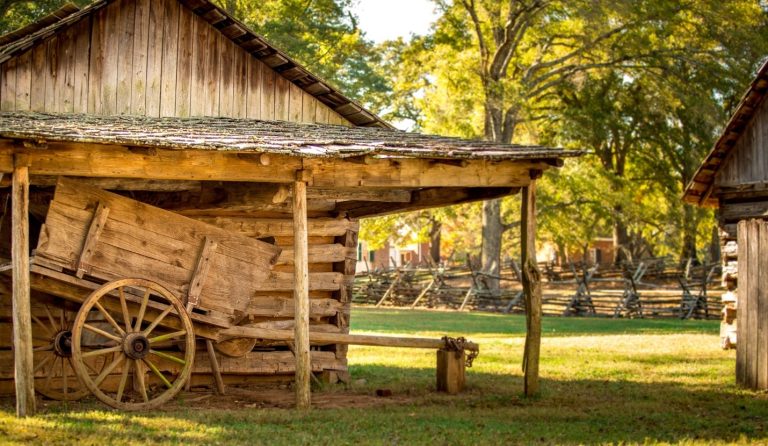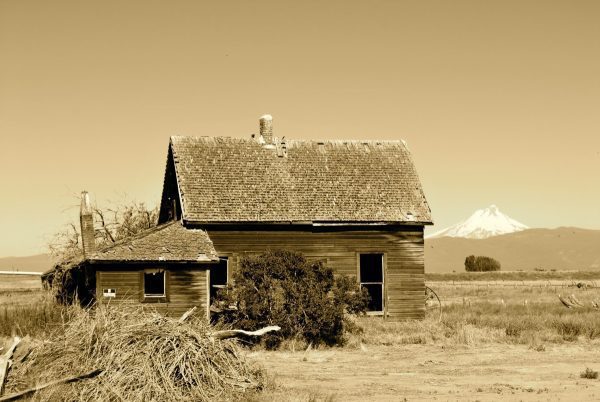Homesteading in the United States Part 2
Previously we learned about the Homestead Act and what it meant for our ancestors. We will continue this series by learning what the Homestead Act means for genealogists today.
Case Study
Because of all the paperwork required to apply for and claim a homestead, there inevitably is an excellent paper trail for us to research our ancestors. What’s found on these records is best examined by looking at a homesteading ancestor. We’ll look at Swiss immigrant Christian Murri, who homesteaded in Utah in the 1880s.
On 30 October 1882, Christian Murri applied for a homestead. His entry was the Northwest Quarter of Section 22 of Township Three South and Range Four East of the Salt Lake Meridian (NW ¼ Sec 22 T 3S R 4E SLM). This was in Wasatch County, Utah. The application process involved filling out affidavits and paying a $16 fee, equivalent to $478 in 2023.
Christian Murri and his sons built a house on the property in April 1883 and moved into said house on the 14th of that month. He and the witnesses testified that it was a log house with a board floor and a shingle roof measuring sixteen feet by twenty feet. It had a door and two windows and was habitable year-round. Christian and his family stayed on the property after settling there, as it was their only home. Christian testified that the furnishings in his house consisted of a stove, cooking utensils, dishes, a table, six chairs, three beds, and bedding. He had owned the furniture for ten years.
Christian Murri and the witnesses further testified of the improvements made on the farm. Christian had broken and plowed 17 acres and grew wheat, potatoes, oats, alfalfa, and other vegetables. By the time he proved his claim, Christian had been growing crops for five seasons and had 17 acres in crop when he filed his proof. He had built a corral, a stable, a granary, a chicken coop, pig pens, and water ditches on his farm. His farming implements included a plow, two harrows, and a wagon, all of which he’d owned for four years. For him to have grown crops for five years, he likely borrowed farming tools from neighbors the first year.
Christian and the witnesses were asked about the value of the improvements on the land. The house was valued at $100. The ditches were valued at $100. The other things built were collectively valued at $200. This made for a $400 value or $12,805 in 2023.
Because Christian Murri was an immigrant, he had to have declared his intention to become a citizen to start the process and had to be a citizen by the time he finished the process. In his homestead application, he swore that he had declared his intention to become a citizen. However, his naturalization papers, which are filed with his homestead papers, show that his declaration of intention was filed on 30 October 1883. His certificate of citizenship was issued on 18 November 1887.
Christian Murri proved his homestead claim on 27 August 1888. Prior to this, a notice was published multiple times in the newspaper to announce his intent to prove his claim and named four witnesses. Two witnesses, Conrad Abegglen/Abbeglen and Ul(e)rich Buhler, were the witnesses who testified. Each of them and Christian Murri had to answer questions, of which the clerk wrote down the answers. Questions were asked them about Christian’s land, his use and residence thereof, and that of his family.
Conrad and Ulrich, like Christian, were farmers. They were asked how often they saw Christian Murri on his land, and both indicated they were there every two or three weeks and saw the family working on their farm. They also were asked how long they knew Christian, how far away they lived from him, and who lived closer to him. They both lived three miles away, and both answered that John Kumer at SW ¼ Sec 22 Tp 3S R 4E and John Huber at NE ¼ Sec 21 Tp 3S R 4E lived closer to Christian Murri. Here we have evidence of five men who were neighbors and have the legal land descriptions of three of those men. This is very useful for FAN club research for Christian Murri. Furthermore, there’s evidence of how well these men knew each other.
The patent for Christian’s homestead was issued on 5 September 1888; Christian now owned the land.
Christian Murri did not claim any military service. If he had, he would have had to file an affidavit to verify it. If your ancestor was a Union Veteran of the Civil War and wanted to claim that service on his homestead, his homestead files will include a military affidavit, which gives information about his military service.

Where to find records
One place to look for records online is the Bureau of Land Management (BLM) General Land Office (GLO) website (https://glorecords.blm.gov/search/default.aspx). Here you have a few different search options. Under location, you can choose a state and a county from the dropdown. You can enter your ancestor’s name and select whether to search patentees or warrantees. In the land description section, you can enter the township and range number, the meridian, and the section number. Under Miscellaneous, you can select a land office, enter a document or survey number, or enter an issue date range. It is important to note that only records of completed homesteads will be here.
Additional records can also be found through the state office websites of the BLM. From https://www.blm.gov/, hover over States and select the appropriate state. For Christian Murri, this was Utah. From the state BLM page, navigate to the public rooms page. On this page for Utah, there’s a link for Utah Land Records, in which the patent, plat map, and interactive map were found for Christian Murri’s homestead. The page for each state has a different setup, but the contact information is in a prominent place on each page. By calling or emailing the appropriate office, you can contact someone who can direct you to homesteading records for that state.
The National Archives (NARA) also houses homestead records. Some are digitized with Fold3 or Ancestry. You may need to contact NARA if your ancestor’s records are not online on Ancestry or Fold3.
- Ancestry database of homestead records, 1863-1908: https://www.ancestry.com/search/collections/60593/
- Fold3 database for Nebraska homestead records, 1863-1908: https://www.fold3.com/publication/650/homestead-records-ne
- For instructions on accessing NARA land records, see their article.
Tract books, which can be browsed on FamilySearch, show the land that was purchased and homesteaded. If the land was homesteaded, it will indicate whether the homestead was completed or canceled. The Utah tract books are organized by township and range number, so it was necessary to know that Christian Murri was in Section 22 of Township 3 South Range 4 East to find his entry. Most likely, as in the case of Christian Murri, it will be necessary to know your ancestor’s legal land description to find it in a tract book. If your ancestor abandoned the homestead, this is where you’ll find the records.
If your ancestor did not complete a homestead and you’re unsure if it was attempted, you may need to search for other clues. One record type to search is in newspapers because homestead cancellations made the papers. Another record type to search is censuses. Homesteading clues in censuses will be birthdates and places of family members suggesting a westward migration after 1862. Additionally, the head of the household would be a land-owning farmer. Next, check the agricultural schedule to see how many acres of land your ancestor had: 160 acres for a whole portion or 80 for a half portion. Another place to check is the deed books. The grantee would be the United States for homesteads and federal land sales. Also, check tax lists and probate records. Probate records would contain the land description.
The FAN (Friends Associates Neighbors) club should also be utilized in homestead research, as seen in Christian Murri’s case. To learn more about his neighbors beyond what the homestead files reveal, census records can be searched for him; his neighbors should appear on the same or adjacent pages. Land records can also be explored to determine if he later sold his land. It’s possible that Christian’s neighbors were also his fellow churchgoers, so church records can be searched to verify this.
It is always good to know the historical context. A good source for that is county and town histories and historical monographs. This may give some insight into your ancestor’s homesteading experience. Christian Murri is a known Mormon pioneer, so learning about Mormon migrations to Utah is a useful historical context for learning his story. Whatever ethnicity your ancestor was, learn why those people traveled to the U.S. or migrated westward.

A fun part of homestead research is looking at the maps. The GLO website has maps of the homestead land, with orange squares to show the section and the homestead. The Utah Land Records website had its own maps for Utah, which show the townships and ranges and the sections therein. HistoryGeo is a paid subscription site where you can look up maps of your ancestor’s land. Google Maps can aid in finding modern homestead land. You can’t enter a township and range into Google Maps; rather, search for a town or landmark nearby (based on what you see on the GLO or other maps) and scroll and zoom until you see the land you’re looking for.
Like any other records, homestead records can provide valuable clues to continue research. Based on what was found in Christian Murri’s homestead record, several research suggestions were made to the client. Census research would confirm when he arrived in the U.S. and how long he lived on his homestead after claiming it. If he moved away, search for land records for a land sale. If he died on his homestead, search probate records in Utah to determine how the land was distributed after his death. The homestead records contained Christian’s declaration of intention and certificate of naturalization but no petition for naturalization. Court records within the U.S. Third Judicial Court in Utah can be searched to find that. Searching for his family on passenger lists would further confirm his arrival in the U.S. Since the homestead papers indicated he paid taxes and voted in Midway, Wasatch, Utah, those records can be searched in that locality.
Did your ancestor homestead land? If you’d like to find out, Lineages can help you.
By Katie
Resources
- All images are public domain
- https://familytreewebinars.com/webinar/the-homestead-act-of-1862/?category=records&subcategory=homestead1862
- https://familytreewebinars.com/webinar/homestead-act-of-1862-following-the-witnesses/?category=records&subcategory=homestead1862
- https://familytreewebinars.com/webinar/women-homesteaders-and-genealogy-bonus-webinar-for-subscribers/?category=records&subcategory=homestead1862
- https://www.familysearch.org/rootstech/session/ladies-and-land
- https://www.familysearch.org/rootstech/session/immigration-and-the-homestead-act-finding-your-ancestors
- https://www.familysearch.org/rootstech/session/go-west-american-migration-1783-to-1900
- https://www.familysearch.org/rootstech/session/ethnic-and-religious-community-formation-under-the-homestead-act
- https://www.familysearch.org/rootstech/session/the-roots-beneath-your-feet-stories-from-homesteading-descendants
- https://www.familysearch.org/rootstech/session/3-the-lay-of-the-land-using-american-land-records-in-your-family-history-research
